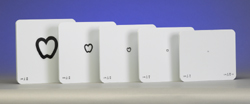
Flash Cards
#252700

Test procedure originally designed by Karen Fern, O.D.
LEA SYMBOLS® developed by Lea Hyvärinen, M.D.
This set of LEA SYMBOLS® Flash Cards for testing visual acuity at distance was designed for children and adults who have difficulty being tested with a visual acuity chart, the Crowded Symbol Book test or even with the Single Symbol Book test.
Before testing be sure to take into consideration the child's developmental level and response patterns. Always use the cards well within the child’s cognitive visual sphere, the space within which the use of vision is possible. The following directions may need to be adapted.
-
Present the cards one by one in order of decreasing symbol size. The child responds by naming or matching. For matching use either the Response Key Card, the Flash Cards or the 3D LEA 3-D Puzzle.
-
Present two cards in the child's best visual location utilizing a "two alternative forced choice" technique. Use one of the following pairs of cards: circle/apple, house/square, circle/house.
-
The child's task is to indicate the location of the specified card
(i.e. apple). The child may respond in several ways:
a) Pointing toward the requested symbol with gaze, hand or head movement.
b) Utilizing a ‘yes’/’no’ response. You show the card with the symbol that you mention (Yes-answer expected) or another card (No-answer expected). If the answer is incorrect, never let the child know it. Just take the card with the next larger symbol and say ”And on this card, is this …?”
This test is often used at a distance other than 3 meters (10 feet). Measure and record the viewing distance and record the symbol size (the M value) or the visual acuity value printed on the card with the smallest symbols identified correctly.
To determine the visual acuity use one of the following formulas:

Note that it is incorrect to report ‘ V.A. 20/25 at 2.5 feet’ if the child could read the 20/25 (10/12.5)-line (3.8M -line) at 2.5 feet. Visual acuity is in that case: 2.5’/10’ x 20/25 = 1/4 x 20/25 = 20/100. (When using the British notation: 6/9 line at 75cm equals: 0.75m/3m x 6/9 = 1/4 x 6/9 = 6/36. When using the decimal notation 0.8 line at 0.75m equals 0.75m/3m x 0.8 = 1/4 x 0.8 = 0.2)
When the distance is one half (or one fourth) of the standard distance, also the visual acuity value is one half (one fourth) of the value printed next to that line.
If you do not want to do the calculations, report the result as M-value, i.e. in the previous case 3.8M at 2.5 feet (0.75m).
Examples:
If the viewing distance used was 6 feet (180 cm) and the smallest
optotypes correctly recognized were on line 20/50 (0.4).
|
|
M-unit, metric unit is the distance in meters at which the reference optotype C is seen at a visual angle of 5'.
[ Instructions I Paediatric Vision Tests I Vision Tests ]
This document was last modified on